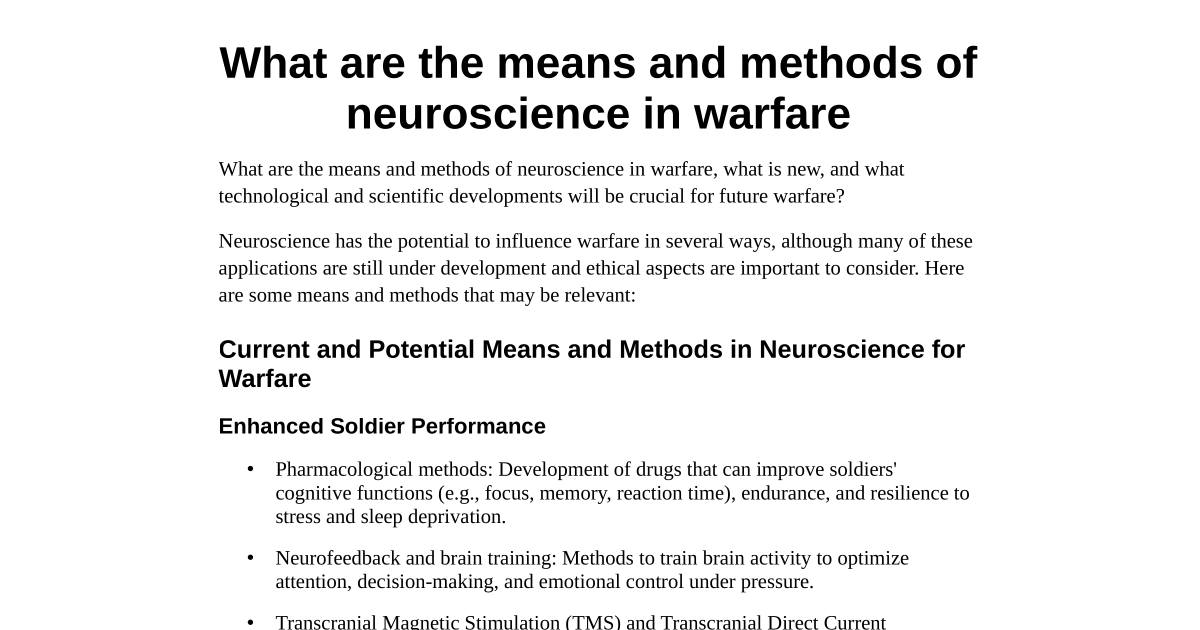What are the means and methods of neuroscience in warfare, what is new, and what technological and scientific developments will be crucial for future warfare?
Neuroscience has the potential to influence warfare in several ways, although many of these applications are still under development and ethical aspects are important to consider. Here are some means and methods that may be relevant:
Current and Potential Means and Methods in Neuroscience for Warfare
Enhanced Soldier Performance
- Pharmacological methods: Development of drugs that can improve soldiers’ cognitive functions (e.g., focus, memory, reaction time), endurance, and resilience to stress and sleep deprivation.
- Neurofeedback and brain training: Methods to train brain activity to optimize attention, decision-making, and emotional control under pressure.
- Transcranial Magnetic Stimulation (TMS) and Transcranial Direct Current Stimulation (tDCS): Non-invasive techniques to stimulate specific brain areas and potentially improve cognitive or motor functions.
Interrogation and Information Gathering
- “Brain fingerprinting”: Techniques claimed to be able to detect if a person recognizes specific information based on brain activity. Controversial and scientifically debated.
- Drug-assisted interrogation: Use of substances to lower inhibitions and potentially increase the truthfulness of statements. Ethically highly problematic and the effectiveness is questionable.
Psychological Warfare and Influence Operations
- Neurotargeting: Utilizing knowledge of how the brain processes information and reacts to stimuli to create more effective propaganda and disinformation campaigns. This may involve tailoring messages to exploit cognitive biases and emotional reactions in the target audience.
- “Neuromarketing” techniques: Principles from neuromarketing, which measures unconscious reactions to stimuli, could potentially be used to design more effective psychological operations.
Development of Non-Lethal Weapons
- Directed energy weapons: Some non-lethal weapons, such as microwave radiation, have effects on the nervous system and can cause temporary incapacitation.
- Chemical substances: Development of chemical substances that specifically affect the brain and behavior without causing death or permanent damage (high ethical threshold).
Countering Psychological Warfare
- Understanding how the brain is affected by disinformation and propaganda is crucial for developing countermeasures and building resilience against psychological manipulation.
What is New?
- Increased understanding of brain function: The rapid development in neuroscience, with new methods for brain imaging (fMRI, EEG, etc.) and analysis of neural networks, provides an increasingly deep insight into how the brain works. This opens up more sophisticated applications in military and security-related fields.
- Integration with AI and machine learning: The combination of neuroscientific data and artificial intelligence enables new forms of analysis and prediction of behavior, as well as the development of more adaptive and personalized influence operations.
- Focus on “non-kinetic” methods: There is a growing interest in methods that do not involve physical violence but rather aim to influence the adversary’s decision-making, morale, and societal stability through psychological and cognitive means.
- Development of neurotechnology: Advances in neurotechnology, such as brain-computer interfaces (BCIs), although primarily developed for medical purposes, may eventually have military applications, e.g., for direct control of weapon systems or communication.
Crucial Technological and Scientific Developments for Future Warfare
- Artificial Intelligence (AI) and Machine Learning: AI will be crucial for analyzing large amounts of data (including neuroscientific data), automating decision-making processes, developing autonomous weapon systems, and creating more sophisticated cyber and information operations.
- Neuroscience and Cognitive Psychology: Continued research on brain function, decision-making, perception, and social cognition will provide deeper insights for developing more effective methods for influence, resilience, and training within the military.
- Neurotechnology and Brain-Computer Interfaces (BCIs): Although still in an early stage, BCIs could eventually revolutionize how soldiers interact with technology and potentially enable new forms of human-machine symbiosis on the battlefield.
- Biotechnology and Genetic Engineering: Developments in biotechnology can lead to new threats in the form of biological weapons, but also to opportunities to improve soldiers’ physiological performance and resilience.
- Cyber Science and Information Warfare: The ability to conduct effective cyberattacks and defend against them, as well as to manipulate information and combat disinformation, will be central to future conflicts.
- Sensor Fusion and Data Analysis: The ability to collect, process, and analyze large amounts of data from various sensors (including biometric and neurophysiological data) in real time will be crucial for situational awareness and rapid decision-making.
It is important to emphasize that the use of neuroscience in warfare raises significant ethical, legal, and social issues that must be addressed carefully. The development and application of these technologies require a transparent and responsible discussion to ensure that they are used in accordance with international norms and human rights.
Mikael Lennart Eleman, April 2025
Download document (PDF)
What are the means and methods of neuroscience in warfare mikael lennart eleman april 2025
